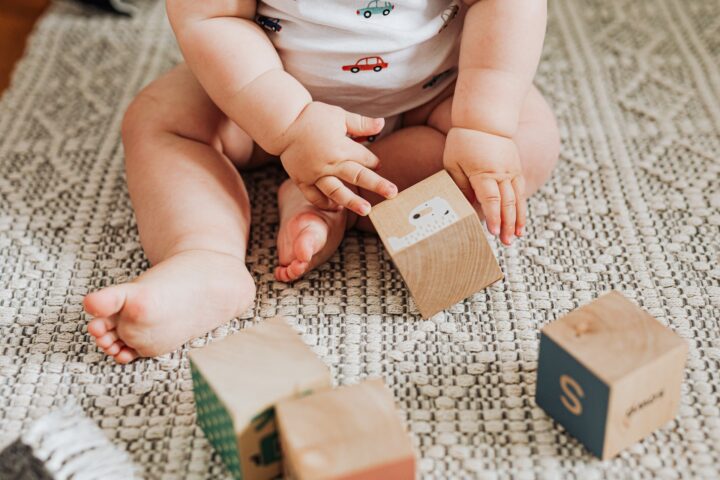Is My Baby Developing Normally? 10 First-Year Milestones To Know About
Watching your child grow from a newborn to a baby is one of the most delightful experiences in a parent’s life. From sleepless nights to mornings filled with cuddles, it can be one of the most rewarding times in your life. However, it is also completely normal to be concerned about your child’s mental and physical development at this time.
It is important to remember that most milestones are in ranges. Not all children are the same, as each child develops at their own unique pace. These milestones should be celebrated instead of being a source of anxiety among families.

Smiling:
One of the earliest milestones you may notice in your baby is smiling. Typically, babies smile between six and twelve months; however, you may notice a smirk right after the baby’s birth.
Reflex smiles are present even before a baby is born; however, you may expect to see a genuine smile after they are two months old. While a reflex smile occurs randomly, and a smile may be there even when the baby is sleeping, a real smile happens as a result of some external factor, such as hearing the voice of either one of their parents, playing peek-a-boo with them, or kissing or cuddling the child.
Tracking objects with their eyes:
At about two months old, the visual coordination of babies improves to the point where they are usually able to follow a moving object with their eyes, and by three months of age, your baby’s eye and arm coordination may be good enough for them to swat a moving object.
By five months, a baby develops depth perception and can see the world in three dimensions. While many of these milestones vary in most children, they do provide helpful information to assess your child’s development. And failure to achieve these milestones can help guide you regarding when you need to take your child to see a pediatrician.
Reach for objects:
Your baby should be reaching for familiar objects by month four, although some infants may begin reaching for toys, their pets, and their caregivers by the third month. At this stage, the child might not be able to grasp the object properly; however, there is effort.
They may also take swipes and reach for dangling objects, though they may not be able to take them yet. Conditions like cerebral palsy and Erb’s palsy are often diagnosed when there is a failure to raise arms or coordinate to reach an object. Parents need to be vigilant about these milestones.
Rolling around:
By the fifth month, you may notice your baby beginning to roll from their stomach to their back and then back to their back. This is a motor skill that requires building certain strength.
However, this is again one of those things that are not set in stone. A baby will roll over at their own pace and when they have built up enough strength and coordination.
Sitting Up:
One of the most important milestones is considered to be sitting up. This varies greatly among children. A child may sit up un-assisted between six and nine months. A baby is ready to sit when they can support their neck; their movements are more purposeful and coordinated.
However, a lot of support from the parents is needed for this, along with some trial and error. You can also support sitting by placing cushions and pillows around them.
Crawling:
A baby mostly starts to crawl between the ages of seven to nine months. Usually, they are able to get on their hands and knees into a crawling position sometime after six months, and you will probably see them ‘commando crawling’ that is, rolling around and crawling on their tummies, by the time they hit the nine-month-old mark.
However, if your child is not crawling, it is not always a cause for worry. Babies mostly crawl as they experiment with alternate ways of moving from one place to another, such as “bottom-shuffling” or “step-scooting.”
Responding to familiar words and babbling:
Between seven to nine months, your baby may start recognizing and responding to familiar words such as their names. They may also start to babble words like “mama” or “dada.” The average is that a child has three spoken words by their first birthday; however, it varies greatly.
Pincer Grasp:
Pincer grasp is a fancy medical term used by pediatricians to refer to a child using his middle finger or forefinger and thumb to grasp or “pinch” an object. It is a fine motor skill that serves various functions, including holding a pencil, self-feeding with utensils or fingers, and zipping and buttoning clothing.
The majority of babies develop a pincer grasp around nine months of age. The early attempts are very clumsy, and initially, the child may not know how to let the object go, so they might offer the object to you, but soon after, the grasp becomes stronger and more accurate.
Taking their first steps:
Watching your baby take their first steps is a milestone that fills most parents with great joy and pride. However, beginning to walk is a milestone that varies greatly across the board but, more or less, most children start to walk almost around one year of age.
Playing imitative games:
By twelve months of age, a child usually learns to play imitative games, such as pretending to speak to someone on the phone or can play pretend. While this may just appear to be a child copying the behavior of the adults around him, in reality, it stimulates a great deal of thinking and imagination to create a fantasy world. This shows high levels of social skills development.
Conclusion:
It is important to remember that most of these milestones are estimates, not facts set in stone. Each child is different, and how they develop varies greatly from the next child. Most of these milestones are there to give us a very rough idea of what a child should be able to do at a certain age.
Slight delays here and there are extremely normal. However, failure to perform certain actions should ring alarm bells and may be a reason for you to visit a children’s specialist. It is better to diagnose a learning disability, a nerve condition such as Erb’s palsy, or a motor developmental defect such as cerebral palsy as early as possible so that care can be given to the child as early as possible.


